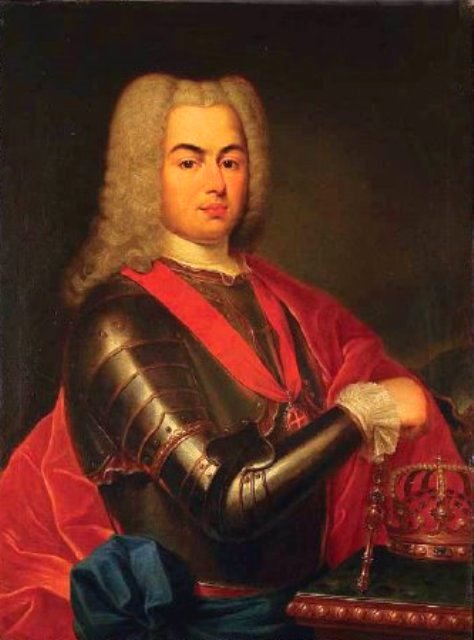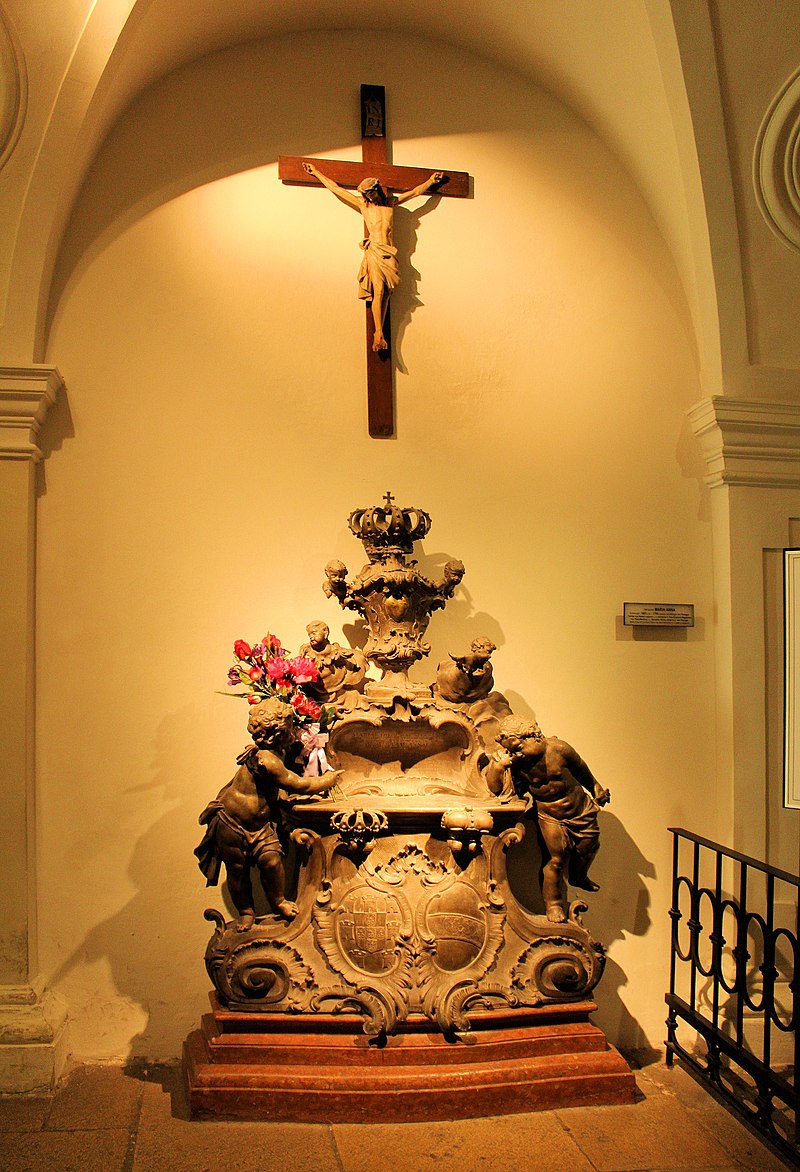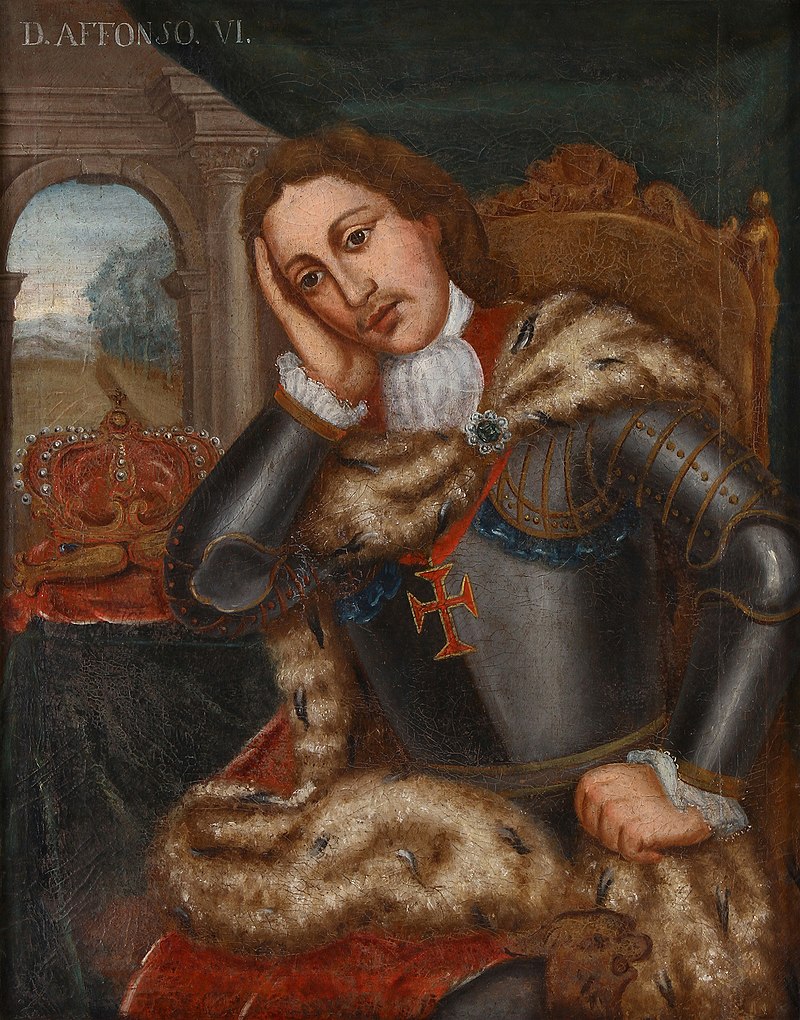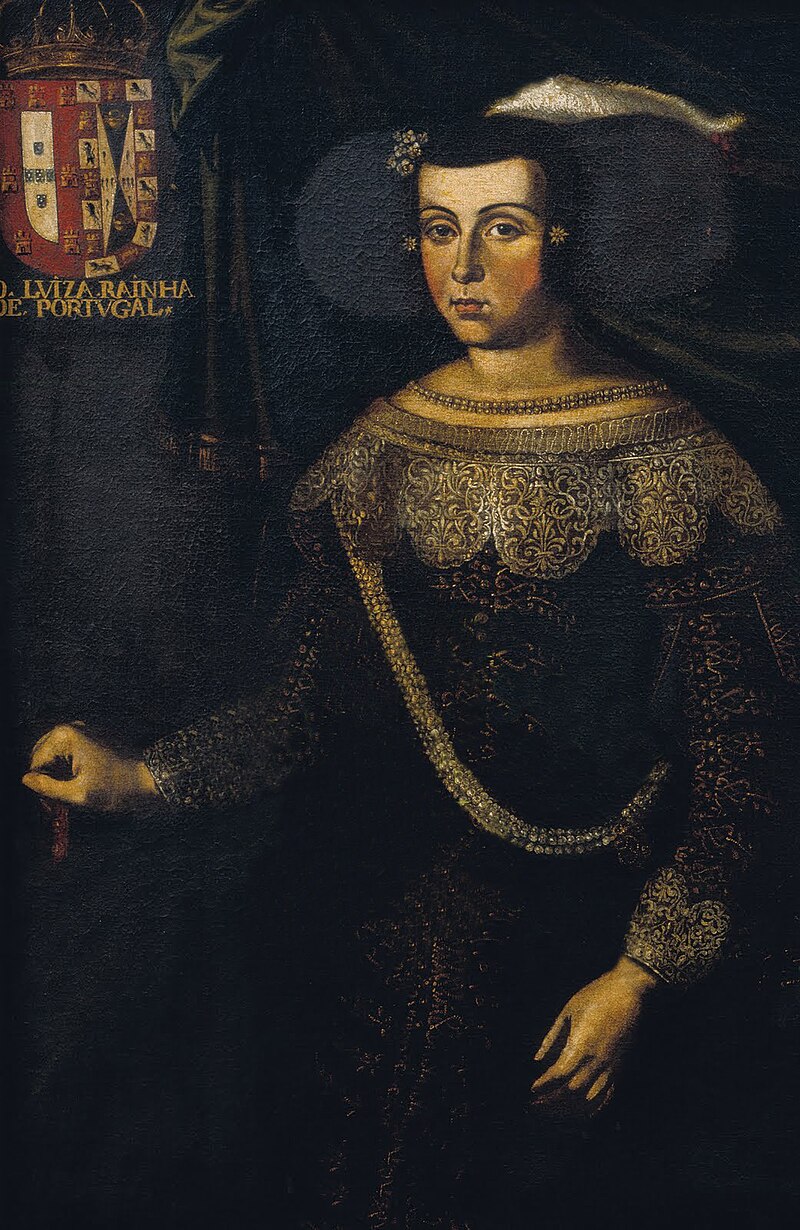by Susan Flantzer
© Unofficial Royalty 2022

Maria I, Queen of Portugal; Credit – Wikipedia
The first of the two Queen Regnants of Portugal, Maria Francisca Isabel Josefa Antónia Gertrudes Rita Joana was born at Ribeira Palace in Lisbon, Portugal on December 17, 1734. She was the eldest of the four children and the eldest of the four daughters of José I, King of Portugal and Mariana Victoria of Spain, and as the heir presumptive to the throne of Portugal, Maria held the titles Princess of Brazil and Duchess of Braganza. Maria’s paternal grandparents were João V, King of Portugal and Maria Anna of Austria. Her maternal grandparents were Felipe V, the first Bourbon King of Spain, and his second wife Elisabeth Farnese. Felipe V of Spain was born into the French royal family as Philippe, Duke of Anjou, and was a grandson of Louis XIV, King of France. In 1700, when the last Spanish king of the House of Habsburg, Carlos II, King of Spain, died childless with no immediate Habsburg heir, he named 16-year-old Philippe of Anjou, Duke of Anjou as his successor.

Maria at the age of five; Credit – Wikipedia
Maria had three younger siblings, all sisters:
- Maria Ana Francisca of Portugal (1736 – 1813), unmarried
- Maria Doroteia of Portugal (1739 – 1771), unmarried
- Maria Benedita of Portugal (1746 – 1829) married her nephew José, Prince of Brazil, Duke of Braganza (the eldest child and heir of Maria I, Queen of Portugal until his death from smallpox), no children

Maria’s husband and paternal uncle Infante Pedro of Portugal, later her co-ruler as Pedro III; Credit – Wikipedia
Because her father had no sons, it was inevitable that Maria would become the reigning Queen of Portugal. However, since female succession to the throne of Portugal had never happened before, her father decided that Maria would marry his younger brother Infante Pedro of Portugal, the first male in the line of succession. On June 6, 1760, 25-year-old Maria married her 42-year-old paternal uncle Pedro.

Maria and Pedro’s eldest son José, Prince of Brazil who died from smallpox; Credit – Wikipedia
Maria and Pedro had six children:
- José, Prince of Brazil (1761 – 1788), married his maternal aunt Infanta Benedita of Portugal, no children, José died from smallpox
- João Francisco of Braganza, Infante of Portugal (born and died 1763), died in infancy
- João VI, King of Portugal (1767 – 1826), married Infanta Carlota Joaquina of Spain, had nine children
- Mariana Victoria of Braganza, Infanta of Portugal (1768 – 1788), married Infante Gabriel of Spain, had three children, Mariana Victoria died from childbirth complications along with her last child
- Maria Clementina of Braganza, Infanta of Portugal (1774 – 1776), died in childhood
- Maria Isabella of Braganza, Infanta of Portugal (1776 – 1777), died in infancy
During the reign of Maria’s father José I, his government was completely dominated by Sebastião José de Carvalho e Melo, 1st Marquis of Pombal, his chief minister. Pombal effectively ruled the Portuguese Empire from 1750, when José I ascended the throne until he died in 1777. Maria and her mother Mariana Victoria disliked the influence Pombal had over José I. In 1759, after a failed assassination attempt on José I, Pombal held the powerful Távora family completely responsible, resulting in the scandal, the Távora Affair. Pombal ordered the execution of all members of the Távora family and it was only because of the intervention of Maria and her mother Mariana Victoria that some women and children were spared. The guilt or innocence of the Távoras family is still debated today by Portuguese historians. Some historians believe it was an attempt by Pombal to contain the growing powers of the old aristocratic families.

Maria I, Queen of Portugal and her husband and uncle Pedro III, King of Portugal; Credit – Wikipedia
After José I suffered a series of strokes, his wife Mariana Victoria was created Regent of Portugal on November 29, 1776, and remained Regent until José’s death on February 24, 1777, when his eldest daughter became the first queen regnant of Portugal, reigning as Maria I. Maria’s husband Pedro became co-monarch, as Pedro III, King of Portugal, when Maria ascended the throne. Pedro was only a nominal king because the actual regal authority was vested solely in Maria. He never participated in politics and always left government affairs to his wife. Mariana Victoria had a significant influence on her daughter Maria and acted as an advisor until her death in 1781. Maria hated her father’s chief minister Sebastião de Carvalho e Melo, 1st Marquis of Pombal, and she removed him from his positions. She then issued a restraining order, commanding that Pombal not be closer than twenty miles to her presence. If she were to travel near his estates, he was to remove himself from his house.
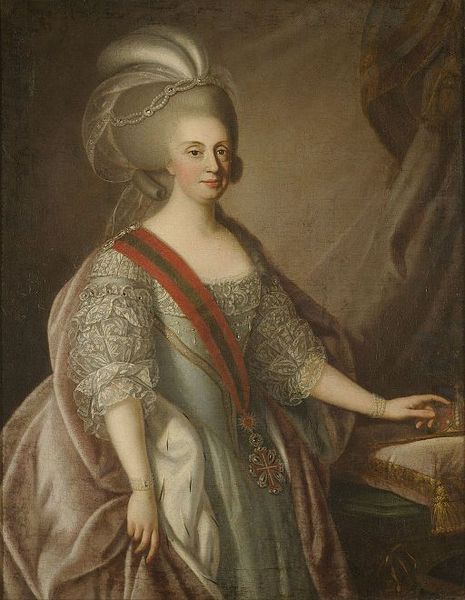
Maria I, Queen of Portugal, 1783; Credit – Wikipedia
Maria I, Queen of Portugal is considered to have been a good ruler in the period before her mental instability, which was first noticed in 1786 when she had to be carried back to her apartments in a state of delirium. Her mental instability continued to worsen. The deaths of her husband Pedro in 1786, her eldest son and heir José in 1788, and her confessor Inácio de São Caetano, Archbishop of Salonica in 1788 may have caused major depressive disorder. Another potential causal factor of her mental instability may have been inbreeding, as Maria’s two unmarried sisters Maria Ana Francisca and Maria Doroteia had similar conditions.

Maria’s second son and new heir, the future João VI, King of Portugal, as Prince Regent, pointing to a bust of his mother; Credit – Wikipedia
In February 1792, Maria was treated by Francis Willis, the same doctor who treated the British King George III. Willis wanted to take Maria to England, but the plan was rejected by the Portuguese Cortes (parliament). As a result, Willis’ role in Maria’s care was more advisory, rather than the hands-on care he had given to King George III, and Willis deemed her incurable. With no hopes of an improvement, Maria’s second son and new heir, the future João VI, King of Portugal, took over the government on her behalf but he did not assume the title of Prince Regent until 1799.
In late 1807, Spanish and Napoleonic forces threatened Portugal, causing Prince Regent João, in the name of his mother Queen Maria I, to move the royal court from Lisbon to Rio de Janeiro, in the Portuguese colony of Brazil. In 1815, Prince Regent João’s government elevated Brazil to the status of a kingdom, and Maria was proclaimed Queen of the United Kingdom of Portugal, Brazil, and the Algarves. When Napoleon was finally defeated in 1815, Maria and her family remained in Brazil.

Maria I’s tomb in the Estrela Basilica; Credit – By © José Luiz Bernardes Ribeiro, CC BY-SA 3.0, https://commons.wikimedia.org/w/index.php?curid=24597402
Maria spent the last eight years of her life in Brazil, always in a state of mental instability. On March 20, 1816, Maria I, Queen of Portugal died, aged 81, at the Carmo Convent in Rio de Janeiro, Brazil. She was initially interred at the Convent of Ajuda in Rio de Janeiro, Brazil. In 1821, when the Portuguese royal family returned to Portugal, Maria’s remains were transported to Lisbon where she was buried in the Estrela Basilica, a church she ordered to be built. Shortly after her wedding to her uncle Pedro, Maria made a vow to build a church and convent if she was given the gift of children that would assure the succession of the House of Braganza. The Estrela Basilica was the fulfillment of her vow. Despite her mental instability, in Brazil, Maria is admired as an important figure in the eventual independence of Brazil. It was during her reign, although through the government of her son’s regency, that many of the national institutions and organizations in Brazil were created.
This article is the intellectual property of Unofficial Royalty and is NOT TO BE COPIED, EDITED, OR POSTED IN ANY FORM ON ANOTHER WEBSITE under any circumstances. It is permissible to use a link that directs to Unofficial Royalty.
Works Cited
- En.wikipedia.org. 2022. Estrela Basilica – Wikipedia. [online] Available at: <https://en.wikipedia.org/wiki/Estrela_Basilica> [Accessed 15 June 2022].
- En.wikipedia.org. 2022. Maria I of Portugal – Wikipedia. [online] Available at: <https://en.wikipedia.org/wiki/Maria_I_of_Portugal> [Accessed 15 June 2022].
- Flantzer, Susan, 2022. José I, King of Portugal. [online] Unofficial Royalty. Available at: <https://www.unofficialroyalty.com/jose-i-king-of-portugal/> [Accessed 15 June 2022].
- Flantzer, Susan, 2022. Mariana Victoria of Spain, Queen of Portugal. [online] Unofficial Royalty. Available at: <https://www.unofficialroyalty.com/mariana-victoria-of-spain-queen-of-portugal/> [Accessed 15 June 2022].
- Louda, Jiri and Maclagan, Michael, 2002. Lines of Succession. London: Little, Brown.
- Pt.wikipedia.org. 2022. Maria I de Portugal – Wikipédia, a enciclopédia livre. [online] Available at: <https://pt.wikipedia.org/wiki/Maria_I_de_Portugal> [Accessed 15 June 2022].














